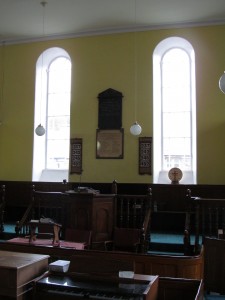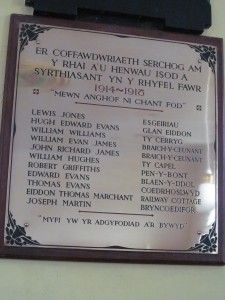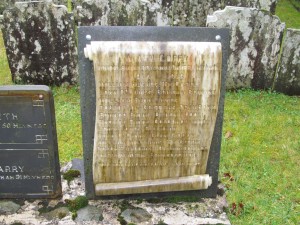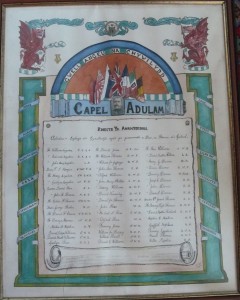The Chapel Memorials in Rhyd-y-main, Meirionnydd
In the Independent chapel in Rhyd-y-main (six miles from Dolgellau on the way to Bala), there is a brass plaque in a prominent position to commemorate the local men who were killed in the First World War. It is situated on the wall behind the pulpit, so that any worshipper who is looking at the minister will have the memorial in their line-of-sight.
situated on the wall behind the pulpit, so that any worshipper who is looking at the minister will have the memorial in their line-of-sight.
The inscription reads:
ER COFFAWDWRIAETH SERCHOG AM
Y RHAI A’U HENWAU ISOD A
SYRTHIASANT YN Y RHYFEL FAWR
1914-1918
“MEWN ANGHOF NI CHANT FOD”
(In loving memory of those who are named below who fell in the Great War 1914-1918, “They shall not be forgotten”). After the list of names, including their home addresses, there is a verse from the Bible: “MYFI YW YR ATGYFODIAD A’R BYWYD” (‘I am the resurrection and the life’: John 11:27). These words are familiar, and one can find similar inscriptions in chapels and churches all over Wales.
There are eleven names listed:
Lewis Jones  Esgeiriau
Esgeiriau
Hugh Edward Evans Glan Eiddon
William Williams Ty Cerryg
William Evan James Braich-y-Ceunant
John Richard James Braich-y-Ceunant
William Hughes Ty Capel
Robert Griffiths Pen-y-Bont
Edward Evans Blaen-y-Ddol
Thomas Evans Coedrhoslwyd
Eiddion Thomas Marchant Railway Cottage
Joseph Martin Bryncoedifor
Interestingly, these same eleven names are to be found in the memorial tablet of another local chapel. Siloh was a Calvinistic Methodist chapel between Rhyd-y-main and Bryncoedifor, founded in 1874 which is now a private dwelling. Its marble tablet is now located in the chapel’s graveyard.
Thus, whereas most chapels in Wales commemorate only those from their own congregation who served and fell, in this case both chapels have made the decision to jointly honour all the men from the area who were killed. At a time when there was a fair degree of rivalry between the different denominations, perhaps this is an indication that they saw that they were united by their grief more than they were divided by their doctrinal differences.
Almost all of the men commemorated here can also be found on Dolgellau’s war memorial. Research on these tells us more about them (the sources of information consulted are a booklet to be found in Meirionnydd’s archives in Dolgellau, and the website http://www.roll-of-honour.com/Merionethshire/Dolgellau.html ).
Edward Evans Son of John and Jane Evans of Blaenyddol, Rhydymain. Served with the 2nd Battalion, Royal Welsh Fusiliers. Killed in action at Bullecourt 27 May 1917, aged 25. Commemorated on the Arras Memorial
Hugh Edward Evans Son of Griffith and Mary Anne Evans of Glan Eiddon, Rhydymain. Served in the Royal Army Medical Corps, with the ‘Welsh Students’ Company’ that went out to Salonica. Died of malaria in Greece 28 October 1917, aged 23. Buried in Mikra British Cemetery, Kalamaria, Salonika, Greece.
Robert Griffiths [Commemorated on the Dolgellau memorial and in the CWGC records as Robert William Griffith]. Son of David and Elizabeth Griffith of 2, Penybont, Rhydymain Served with the 9th Battalion, Welsh Regiment. Killed in action 20 December 1917, aged 20. Commemorated on the Thiepval Memorial.
John Richard James 10th Battalion, Royal Welsh Fusiliers. 25th Division. Killed in action on the Somme 28th November 1916. Buried in Euston Road Cemetery, Colincamps
William Evan James 10th Battalion, Royal Welsh Fusiliers. 25th Division. Killed in action on the Somme 16th August 1916. Buried in Guillemont Road Cemetery, Guillemont
Both James brothers enlisted in London.
Lewis Jones Son of John and Jane Jones of Esgeiriau, Rhydymain. Served in 1st Battalion, The Welsh Guards. Died of wounds at home 25 September 1917, aged 21. Buried in the graveyard of Rhyd-y-main’s Independent Chapel.
Joseph Martin Son of Samuel and Mary Martin of Trewent, Altamon, Launceston, Cornwall. Served in 13th Battalion, Royal Welsh Fusiliers. Killed in action 29 October 1916, aged 24. Buried in Essex Farm Cemetery, Ypres.
Eiddion Thomas Marchant Son of Mr. and Mrs. Thomas Nelson Marchant of Railway Cottage, Rhydymain. Served in 233rd Company, Machine Gun Corps. Killed in action at Ypres 4 October 1917, aged 21. Commemorated on the Tyne Cot Memorial, Belgium
William Williams Served in 2nd Battalion, Royal Welsh Fusiliers. Died of wounds 21 September 1918. Buried in Thilloy Road Cemetery, Beaulencourt
Of the other two men commemorated, it is quite likely that William Hughes can be identified –
William Hughes [Probably] Son of William and Ann Hughes of 91 High Street, Blaenau Ffestiniog. Served in 1/5th Battalion, South Wales Borderers. Wounded in action on the Marne Front and died of wounds on 30 May 1918, aged 19. Commemorated on the Soissons Memorial
However, the research that is available does not identify Thomas Evans of Coedrhoslwyd.
g.h.matthews March 7th, 2016
Posted In: chapels / capeli, iconography, memorials
Adulam Bonymaen Roll of Honour
Since the autumn of 2015, the project Welsh Memorials to the Great War has been preparing to investigate the range of First World War memorials in Wales. Generously funded by the Living Legacies Engagement Centre, this project aims to begin to fill a gap in our knowledge and appreciation of ‘unofficial’ war memorials in Wales. Although a lot of work has been done on commemoration of the war in Wales, the tendency has been to focus on the ‘official’ memorials. The available databases do a good job of listing these, what you might call the ‘village green’ memorials, but they are very patchy when it comes to memorials that were set up by chapels, workplaces, schools and societies.
As well as creating and sharing a database, the project will also explore different ways in which these memorials can be analysed by researchers. The database could be used to facilitate:
– a ‘micro-history’, focussing in closely on one memorial and doing a biographical analysis of the names listed.
– a study of the distribution of the memorials, and how there are different patterns of commemoration across Wales
– a study of the iconography of the memorials, and again how this differs across regions
– looking at patterns of inclusion, for instance by examining those memorials that list women as well as
men.
As we work to get the project up-and-running, I have continued to gather images of chapel memorials. I find these very enlightening as to the attitudes of people and communities across Wales to the war. Of course, prior to August 1914, these institutions were strongly anti-militaristic, but we can see how that was transformed by studying the Roll of Honour in Adulam Baptist chapel, Bon-y-maen (north Swansea).
This Roll of Honour lists (as many chapel memorials do) all of those who served in the War, not just the fallen: in this case, 48 men. The number of names is not surprising: other Baptist chapels in the north Swansea area have 81 (Caersalem Newydd, Treboeth), 99 (Seion, Morriston) and 52 (Soar, Morriston). In 1914, Adulam had 231 members (a smaller membership than the other three chapel mentioned above) so one can be sure that the majority of young Adulam men who were eligible did join up.
This Roll of Honour is interesting and unusual in that its creator has signed it (T. Lewis of Morriston), with the date 1917. Therefore this was a ‘live’ document, added to as the war dragged on and more Adulam men were called up. One can see from the spacing at the bottom of the document that some of the names were squeezed in. Also, the names of battles were added to the pillars on either side, including a battle fought in 1918.
The design of this memorial is different to all those I have studied previously, though many of the features are familiar. The two red dragons in the top corners of the memorial is a feature seen in Penuel chapel, Loughor. The collection of Allied flags in the centre of the roll can also be seen in the Roll of Honour at Bethel, Llanelli. The pillars flanking the list of names are also a feature of the two memorials in Mynydd Bach chapel. One unexpected aspect I have never previously encountered is the image of Kitchener, just beneath the flags. It is indeed surprising to have a picture of a warrior like Kitchener, not known for his sympathy for the ideals of Welsh Nonconformity, in a Welsh chapel.

The wording of this memorial is also significant. ‘Rhestr yr Anrhydeddus’ (literally ‘List of the honourable ones’); ‘Aelodau’r Eglwys a’r Gynulleidfa sydd yn gwasanaethu eu Duw, eu Brenin a’u Gwlad’ (‘Members of the Church and the Congregation who are serving their God, their King and their Country’). Many Welsh chapel memorials will have wording that declares that the men fought for ‘Rhyddid’ (‘Freedom’) and ‘Anrhydedd’ (‘Honour’) but it is not common to have such an explicit declaration that they were fighting for ‘Duw’ (God’).
The key question which we must be careful in answering is whether we can infer from this memorial that the chapel accepted the argument that this was a just war. We cannot say for sure that the whole congregation was committed to fighting the war to the end, whatever the cost, but it is clear that the chapel’s leadership did adhere to the line that this was a war for right against might. I believe the fact that the memorial was commissioned in 1917 is significant: by then any illusions that people might have had early in the war that it would be over quickly had long since disappeared. Britain was not winning the war in 1917, but losing a constant stream of men in battles that did not appear to bring victory any closer. Yet this document still declares that the cause is just, for if God is on the Allies’ side, there can be no question about whether or not we are in the right.
Supporting evidence comes from the pages of the local newspapers, the Cambrian Daily Leader and the Herald of Wales. Searching the online database of the tremendous resource Cymru1914.org it is easy to come across reports of well over a dozen of the servicemen being honoured by the chapel when they returned home on leave, or were demobbed at the end of the war. (See, for example, the reports on Gwilym Leyshon and Willie Martin ).
Thus this single memorial contains a wealth of information that can help us understand how this community reacted to the war. The aim of the project is to share the details of a few hundred Welsh memorials, giving us the opportunity to examine how people and communities across Wales responded to the challenges of this unprecedented war, and thus a better idea of how the Welsh nation as a whole was scarred by the experience.
Dr Gethin Matthews, Swansea University
Meg Ryder February 15th, 2016
Posted In: iconography, memorials
Tags: chapels / capeli, iconography, Kitchener, memorials, Swansea, WW1

